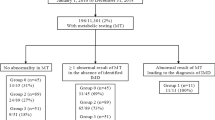Summary
Qatar is a country in the Gulf area and member of the Gulf Cooperation Council states. The country is populated by original Qatari tribes that amount to about 200 000 people and about 600 000 expatriates mainly from Arabic and Asian countries. Inbreeding over centuries and high rates of consanguinity in the Qatari population and in some groups of expatriates, in addition to large family sizes and rapid population growth, have contributed to a high frequency of autosomal recessive disorders. In December 2003 Hamad Medical Corporation in Doha and the University Children’s Hospital of Heidelberg, Germany, started an extended state-wide neonatal screening programme for metabolic and endocrine disorders, with the laboratory situated in Heidelberg, Germany. All aspects of the screening process had to be adapted to the unique situation of the laboratory being 6000 km from the birthplace of the neonates. Within 32 months, samples of 25 214 neonates were screened. In 28 cases an endocrine or metabolic diagnosis was identified (incidence 1:901, in Germany 1:1728). In particular, a variety of monogenic metabolic diseases were prevalent, with 19 patients detected giving an incidence of metabolic diseases of 1:1327 (Germany 1:2517). Each euro spent on the screening programme saved more than 25 euros in health and social costs. The programme revealed a high incidence of treatable inborn metabolic diseases in the population of Qatar. A reliable screening for classical homocystinuria showing a unique incidence of >1:3000 and for sickle cell disease has now been added.
Similar content being viewed by others
References
Al-Riyami A, Ebrahim GJ (2003) Genetic Blood Disorders Survey in the Sultanate of Oman. J Trop Pediatr 49(Suppl 1): 11–20.
Bener A, Hussain R (2006) Consanguineous unions and child health in the State of Qatar. Paediatr Perinat Epidemiol 20: 372–378.
Bettendorf M (2002) Thyroid disorders in children from birth to adolescence. Eur J Nucl Med Mol Imaging 29(Suppl 2): S439–446.
Christianson A, Howson CP, Modell B (2006) Global Report on Birth Defects. White Plains, NY: March of Dimes Birth Defects Foundation. (marchofdimes.com/globalprograms, February 2006).
El-Said MF, Badii R, Bessisso MS, et al (2006) A common mutation in the CBS gene explains a high incidence of homocystinuria in the Qatari population. Hum Mutat 27: 719.
Fang-Hoffmann J, Lindner M, Shahbek N, Barić I, Hoffmann GF (2006) Metabolic medicine: new developments in diagnosis and treatment of inborn errors of metabolism. World J Pediatr 2: 169–176.
Interdisziplinäre Screeningkommission der Deutschen Gesellschaft für Kinderheilkunde und Jugendmedizin (2002) Richtlinien zur Organisation und Durchführung des Neugeborenenscreenings auf angeborene Stoffwechselstörungen und Endokrinopathien in Deutschland. Monatschr Kinderheilkd 150: 1424–1440.
National Newborn Screening and Genetics Resource Center, in collaboration with CDC and the Health Resources and Services Administration (workshop in San Antonio, Texas). CDC MMWR Recommendations and reports 2001/50(PR03): 1–22.
Pettit DA, Amador PS, Wolf B (1989) The quantitation of biotinidase activity in dried blood spots using microtiter transfer plates: identification of biotinidase-deficient and heterozygous individuals. Anal Biochem 179: 371–374.
Schulze A, Lindner M, Kohlmuller D, Olgemoller K, Mayatepek E, Hoffmann GF (2003) Expanded newborn screening for inborn errors of metabolism by electrospray ionization-tandem mass spectrometry: results, outcome, and implications. Pediatrics 111: 1399–1406.
Wilcken B, Wiley V, Hammond J, Carpenter K (2003) Screening newborns for inborn errors of metabolism by tandem mass spectrometry. N Engl J Med 348: 2304–2312.
Zytkovicz TH, Fitzgerald EF, Marsden D, et al (2001) Tandem mass spectrometric analysis for amino, organic, and fatty acid disorders in newborn dried blood spots: a two-year summary from the New England Newborn Screening Program. Clin Chem 47: 1945–1955.
Author information
Authors and Affiliations
Corresponding author
Additional information
Communicating editor: Rodney Pollitt
Competing interests: None declared
Electronic Supplementary Material
Below is the link to the electronic supplementary material.
Rights and permissions
About this article
Cite this article
Lindner, M., Abdoh, G., Fang-Hoffmann, J. et al. Implementation of extended neonatal screening and a metabolic unit in the State of Qatar: Developing and optimizing strategies in cooperation with the Neonatal Screening Center in Heidelberg. J Inherit Metab Dis 30, 522–529 (2007). https://doi.org/10.1007/s10545-007-0553-7
Received:
Revised:
Accepted:
Published:
Issue Date:
DOI: https://doi.org/10.1007/s10545-007-0553-7




